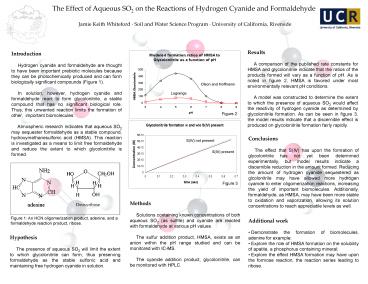Methods PowerPoint PPT Presentation
1 / 1
Title: Methods
1
The Effect of Aqueous SO2 on the Reactions of
Hydrogen Cyanide and Formaldehyde
Jamie Keith Whiteford Soil and Water Science
Program University of California, Riverside
Results A comparison of the published rate
constants for HMSA and glycolonitrile indicate
that the ratios of the products formed will vary
as a function of pH. As is noted in figure 2,
HMSA is favored under most environmentally
relevant pH conditions. A model was
constructed to determine the extent to which the
presence of aqueous SO2 would affect the
reactivity of hydrogen cyanide as determined by
glycolonitrile formation. As can be seen in
figure 3, the model results indicate that a
discernible effect is produced on glycolonitrile
formation fairly rapidly.
Introduction Hydrogen cyanide and
formaldehyde are thought to have been important
prebiotic molecules because they can be
photochemically produced and can form
biologically significant compounds (Figure 1).
In solution, however, hydrogen cyanide
and formaldehyde react to form glycolonitrile, a
stable compound that has no significant
biological role. Thus, this unwanted reaction
limits the formation of other, important
biomolecules. Atmospheric research
indicates that aqueous SO2 may sequester
formaldehyde as a stable compound,
hydroxymethanesulfonic acid (HMSA). This reaction
is investigated as a means to limit free
formaldehyde and reduce the extent to which
glycolonitrile is formed.
Olson and Hoffmann
Lagrange
Figure 2
Conclusions The effect that S(IV) has upon
the formation of glycolonitrile has not yet been
determined experimentally, but model results
indicate a discernible reduction in the amount
formed. Reducing the amount of hydrogen cyanide
sequestered as glcolonitrile may have allowed
more hydrogen cyanide to enter oligomerization
reactions, increasing the yield of important
biomolecules. Additionally, formaldehyde, as
HMSA, may have been more stable to oxidation and
vaporization, allowing its solution
concentrations to reach appreciable levels as
well.
S(IV) not present
S(IV) present
Figure 3
Methods Solutions containing known
concentrations of both aqueous SO2 (as sulfite)
and cyanide are reacted with formaldehyde at
various pH values. The sulfur addition
product, HMSA, exists as an anion within the pH
range studied and can be monitored with IC-MS.
The cyanide addition product, glycolonitrile,
can be monitored with HPLC.
Deoxyribose
Figure 1 An HCN oligomerization product,
adenine, and a formaldehyde reaction product,
ribose.
- Additional work
- Demonstrate the formation of biomolecules,
adenine for example - Explore the role of HMSA formation on the
solubility of apatite, a phosphorus containing
mineral - Explore the effect HMSA formation may have upon
the formose reaction, the reaction series leading
to ribose.
Hypothesis The presence of aqueous SO2 will
limit the extent to which glycolonitrile can
form, thus preserving formaldehyde as the stable
sulfonic acid and maintaining free hydrogen
cyanide in solution.

